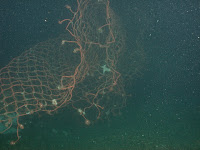Wednesday, November 17, 2010
West Coast Expeditions Go Public
Photos can be posted online almost instantly these days, even from a research vessel. Think of the benefits to science - crowd-sourcing species identifications, plugging into experts from around the world, stimulating research, engaging the public, feeding the media frenzy. It all sounds good, right?
Or does it? Photos and videos are data. They show species, abundance, geology, proximity, etc. Data acquisition is the primary objective of a science career. So, there are disadvantages to data sharing. Someone could publish your data, or misinterpret it. They could scoop you on your big deep-sea story. Or use an image without crediting you. You may be helping your competition by giving it up for free.
Open-access advocates would lead you to believe the benefits of data-sharing outweigh the risks. The theory goes that public information begets more public information. For example, public albums can generate new data through viewer comments and viewer statistics. As traffic routes through the site, you build a demographic profile for your target audience. This new information adds value to the data, and may even supersede it.
To test the open-source idea, NOAA's Southwest Fisheries Science Center (SWFSC) is experimenting with two new public data products from their 2010 deep-sea coral and sponge research. The first is a new online Google database from the SWFSC Habitat Ecology Team in Santa Cruz, CA. The database is called a Google Fusion Table. Data and images for Southern California can be viewed in map form or spreadsheet form.
The second is a new Picasa photo album from the SWFSC Phantom ROV team and marine biologist Dr. Peter Etnoyer. The photo album is a narrative slideshow for sharing with National Marine Sanctuary partners on-shore, the public, and the ship's crew of NOAA Bell M Shimada.
Both image galleries show incredible deep-sea sponges, rockfish, soft corals, and sea stars from 150 to 450 m depth; as well as geological features, and marine debris like a large abandoned trawl net and a discarded cable.
Labels:
deep-sea corals,
MPA,
NOAA,
open-access,
sponges
Subscribe to:
Post Comments (Atom)




Love it!
ReplyDelete